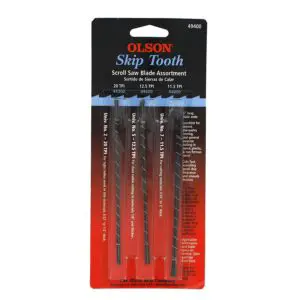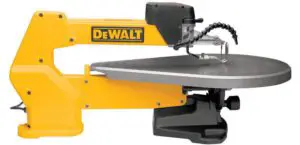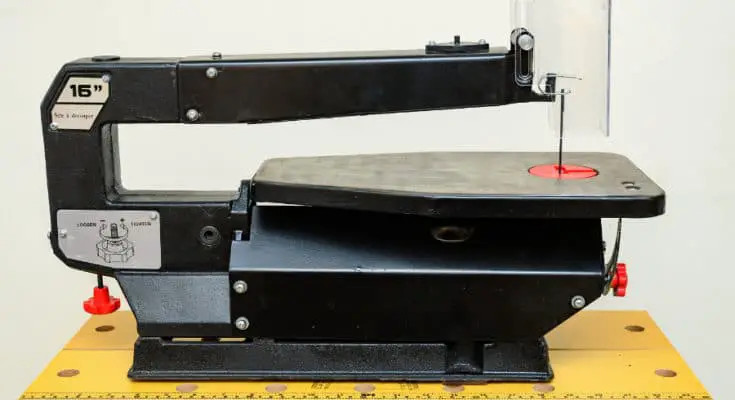We’ve all had those times working on an at-home project where we don’t have a specific tool but we think to ourselves, “I wonder if I could use this tool instead of dropping an exorbitant amount on something I might use once”.
One such case may be if you only have a scroll saw in your shed, is it possible to use it for intricate metalwork?
In this case, the answer is yes provided you have the right tools and accessories on hand, take your sweet time, and stay within a certain set of guidelines.
If planning to undertake a project such as this, do your research and be smart. Fingers are a valuable asset to lose.
What Type of Blades are Needed?
It is absolutely imperative that should you choose to cut any type of metal with your scroll saw, you first purchase the proper blade for such a task.
Having the wrong blade installed will not only make cutting your material next to impossible, it will also strip the standard tempered teeth off the edge of the blade, wasting your hard-earned dollars.
The blades you want are hardened jeweler’s blades. These have specially hardened teeth to better deal with the added stresses of cutting metal and will do a much better job than those that are meant for wood. The best blades that I have found are made by Olson. Amazon sells the for a great price (Click here).
When running jeweler’s blades, you should take care to run them at a slower speed as they tend to break, so always buy spares before you start a project to avoid any hang-ups.
These days due to the growing interest in cutting thin metals with scroll saws, there do seem to be a few blade options on the rise outside of jewelry blades.
 Though meant to handle slightly higher stress levels they still break and require replacement quite frequently. Keep in mind that no matter how high the blade quality the scroll saw is not specifically made for this process, so there will always be shortcomings.
Though meant to handle slightly higher stress levels they still break and require replacement quite frequently. Keep in mind that no matter how high the blade quality the scroll saw is not specifically made for this process, so there will always be shortcomings.
The standard jeweler’s blades will do fine for most people when running thin, ornamental metals, but aside from these, there are two more blade types to note.
The first of these is what’s called a ‘skip tooth’ blade. (Here’s the skip tooth blades on Amazon by Olson). Due to the wider gap between teeth, these blades do a significantly better job of ejecting metal shavings than a fine-toothed jeweler’s blade.
This can get somewhat annoying from a cleanup standpoint, but the better ejection causes for smoother cuts, and easier to read pattern outlines.
The other blade is known as a ‘spiral blade’ and sort of resembles a metal shaft with a winding staircase of saw teeth wrapped around it. You can get a 12 pack here on Amazon.
The spiral blade may be better for softer materials like aluminum due to the widened kerf and increased friction.
Whereas the fine jeweler’s blade might cruise through the metal too quickly, the spiral blade’s hogging action will help to slow down the travel speed a bit, providing more accuracy and control when cutting your pieces.
Due to the spiral nature of the teeth on this blade, you will also be able to cut your lines in any direction, which is a convenient feature.
What Types of Metal Can Be Cut?
Scroll saws were originally meant for executing decorative cuts in wood. Due to this fact, using them for metalworking projects should be more of an exception than a daily occurrence.
Realistically the saw should be able to handle the work, but just because a tool is able to produce work outside of its intended realm doesn’t mean it should be practiced regularly.
If a scroll saw does become your weapon of choice for finer metals, at least steer clear of any heavier metals or plates beyond one-eighth inch thick.
The scroll saw can be used for a decent range of materials such as steel, aluminum, copper, and brass, as long as the proper stock thickness and feeding speed is observed, and any cooling or lubricating liquids are employed if necessary.
What is the Thickest Metal That Can Be Cut?
Though scroll saws are specially tailored toward fine detail work, the skilled hobbyist could probably get away with cutting a decently thick piece of softer metal as long as they were careful and took their time with it.
Obviously, heavier metals like steel or brass will have a lower thickness limit -around one-eighth inch- as they’re denser and take more effort for the machine to cut through.
Even when moving carefully on these materials you will likely need to run coolant and will probably go through blades pretty quickly.
Lighter metals such as copper and aluminum will allow for running thicker pieces with more ease but will still likely take a while and still might require the application of fluid.
If you were really trying, you might be able to get through aluminum up to about half inch thick.
Depending on your model of saw there could be an available coolant reservoir for it, so be sure to look around.
What Limitations Does a Scroll Saw Present When Cutting Metal?
Essentially a scroll saw should be limited to cutting wood, or very thin metals.
If cutting thicker metals with a scroll saw you have to make sure the blade is properly lubricated otherwise you’ll get a nasty, burned cut and break torrents of blades. This creates a dangerous environment and in fact, makes no sense.
Scroll saws are capable of cutting insanely intricate patterns compared to other saws which is why they’re excellent for fine work, but because of this they are delicate machines.
Being that mostly thinner or ornamental metals are cut when using a scroll saw you should just accept the idea that any piece you manufacture is not going to be anything heavy duty. Should you choose to cut anything heavier, be smart and cut your thick stock with appropriate tools.
Some Tips for Using a Scroll Saw on Metal
The first thing to remember about using your scroll saw for any project is to wear safety glasses.
Given the fact that scroll saw blades have the propensity for snapping, should they do so in a catastrophic manner you want your vision orbs nice and protected.
The next major tip is to watch where you put your fingers.
When using a scroll or band saw you only get one chance to keep your hands intact. It is considered safe to push from the front when running larger pieces of work but keep a watchful eye, and don’t get distracted.
When cutting smaller pieces, you should only ever place your digits either next to, or behind the blade to pull the stock through rather than push.
Don’t find yourself in a position where you’re pushing the piece into the blade from the front, your phone rings, and when you check to see who it is you split your pointer right up the middle.
 Normally when running stock through the scroll saw you would keep the work piece flat on the table, only using your fingertips to guide and feed the piece through the blade.
Normally when running stock through the scroll saw you would keep the work piece flat on the table, only using your fingertips to guide and feed the piece through the blade.
If the piece you’re working on should hang off the edge of the table, however, be sure to keep the metal as flat as possible to avoid pinching or binding the blade. This can cause huge amounts of vibration or chatter, an unpredictable work environment, and possible injury.
What you can do to avoid chatter is to lay a piece of one-eighth inch plywood on either side of the metal sheet by sandwiching it all together and then wrapping it lengthwise in a good quality clear packing tape. This is most effective when the wood is the same length and width as the workpiece.
When you cut the pattern out of the middle, the tape will hold the edges in place and keep the wood aligned with the metal. You will be able to push the finished piece out of the middle like it fell out of a cookie cutter.
The plywood technique will also help to curb metal shavings from being kicked around the shop or creating too serious a burr on the bottom side of the kerf, which makes for much easier cleanup in the end.
If using a paper pattern to get your outline down, the best way to do this is to employ the plywood sandwich (described above) and use a spray adhesive to lay the pattern down on top of the wood before taping it all tightly together. This will keep the pieces snug and you won’t have to freehand anything.
If you’re cutting just metal with no backing such as plywood to act as a buffer against vibration, you can cut slightly heavier aluminum if absolutely necessary due to less drag from the wood. If you’re going to be cutting heavier stock without the wood, remember to wear gloves.
The reason for this is that at a certain point the bare metal could become unbearably hot causing a dangerous and uncertain holding situation.




